|
San Benedetto fuori della
Porta a Pinti |
|
|
|
|
|
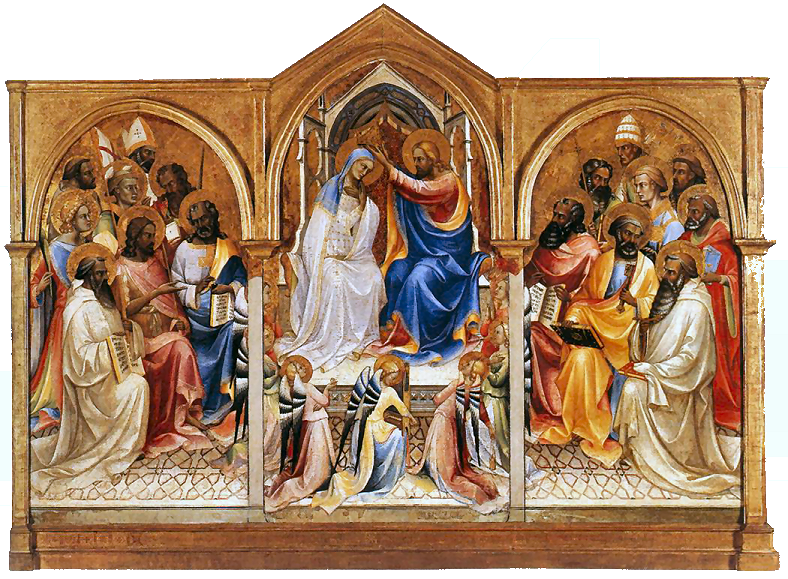
History
A smaller offshoot of the Camaldolese convent of
Santa Maria degli
Angeli, established by seven monks from there (along with four
lay brothers) including two members of
the Ricci family, possibly partially in opposition to the dominant Albizzi
faction. In his will of 1400
Francesco di Jacopo Ricci, whose brother Alessandro was a monk at SM degli
Angeli, left money for a monastery to be founded in or just outside
Florence. Francesco died of the plague that same year. The complex was built on land bought by Don Alessandro just outside the third set of city walls, with help from other
donors from the Spini family. The church was built by1402. Inside the church the chapel of Saint Luke had frescoes and a gold-ground
altarpiece. The chapel of St Anthony was added in 1402, funded by the Corso as a private burial space. A campanile and library followed in 1405,
the church was consecrated in 1407 and choir stalls and Lorenzo Monaco's
Coronation of the Virgin (see right) were installed in 1409. A new
cloister followed in 1412.
The complex was demolished in advance of the Siege of
Florence in 1529/30 so as not to provide shelter for the armies of the Holy Roman Emperor Charles V who,
in league with the Medici Pope Clement VII, was intent on ending the
Florentine Republic for the last time and re-installing the Medici - they
succeeded. Michelangelo had just been made responsible for building
the republic's defences, thereby placing himself in opposition to Pope
Clement VII who was an old friend from when he was just plain Giulio de'
Medici, and a major patron, responsible for Michelangelo getting much work
in San Lorenzo - the building of the Laurentian Library, the Medici Chapel
and the reliquary balcony on the inner façade.
Its treasures were moved to
Santa Maria degli Angeli.
These included manuscripts and the altarpieces mentioned below.
Lost art
Lorenzo Monaco's Coronation of the Virgin (1407-09), the
main panel of which is now in the National Gallery, once stood on the high
altar here. It was later, probably following the 1529 demolition, moved to
the Alberti chapel in the cloister of
Santa Maria degli Angeli, where
Vasari saw it. It was removed from that church in 1792 when it was divided
into three, having originally been a single panel. The flanking
panels of saints were given to the National Gallery in 1848 by William
Coningham but the centre part remained in Italy until 1902, and only in
1940 were all three sections brought together in a new frame. Gaps in the
composition between the panels were filled in by modern additions. Saint
Romuald, the founder of the Camaldolese order, is shown kneeling in a
white habit in the right panel with Saints John the Baptist and Matthew.
In the left panel are Saints Benedict (whose rule the Camaldoli followed),
John the Evangelist and Peter. Predella panels
depicting the Adoration of the Magi and Scenes from the Life of Saint Benedict
are in the National Gallery, the Vatican Pinacoteca and the National
Museum in Poznań in Poland. Pinnacle panels depicting the Virgin
Annunciate, the Prophet Jeremiah and the Blessing Redeemer
are in Pasadena, the Feigen Collection and the Accademia, but some of
these are disputed. The Four
Patriarchs, now in the Met in New York, are even more disputed.
An altarpiece of 1404 of the Virgin and Child with Saints by Niccolò di Pietro Gerini
is now in the Accademia. It was part of an endowment by Domenico di
Francesco Corsi, a
silk merchant, for the chapel of St Anthony Abbot here. The predella
panels depicting scenes from the lives of
Saints Lawrence, John the Baptist and Anthony Abbot and a
central Adoration of the Magi are in the Yale University Gallery, a
private collection, Zagreb and the Berlin Gemäldegalerie respectively.
|
|
San Donato a Scopeto |
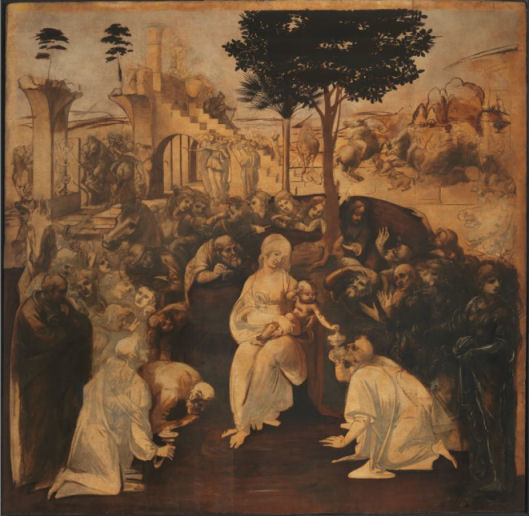 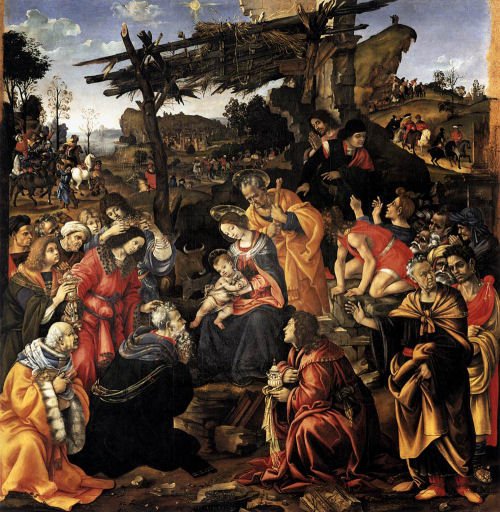
History
The monastery here,
just outside the Porta Romana, the city's southern gate, was acquired by
Cistercian monks from Badia a Settimo in 1370 and taken over by
Augustinians in 1420. At the time Ser Piero da Vinci, Leonardo's father,
was their notary. The complex was demolished during the
siege of Florence in 1529/30, as were most buildings outside the walls,
so that the attacking armies of Emperor Charles V couldn't use them for refuge or supplies. The
Romanesque portico of this church, possibly 11th-century, is now on the
front of
San Jacopo sopr'Arno.
Lost art
Leonardo's dramatically unfinished and
Flemish-influenced Adoration of the Magi (see left) commissioned in 1481, is
now in the Uffizi, as is the less animated but still well-populated panel
(finished in March 1496) that the brothers here got Filippino Lippi to paint on
the same subject to replace it (see right). It is not known why Leonardo's altarpiece
went uncompleted - one theory is that the composition proved too unusual for
the monks - or why a commission to Ghirlandaio, before Lippi got
the job, proved similarly fruitless. The
painting was left unfinished at Giovanni di
Amerigo de’ Benci’s house, near Santa Croce. He being the brother of
Ginevra, whose portrait was famously painted by Leonardo. He had been
working on the Adoration in the summer 1482 when he left for Milan.
It stayed with the family but by 1601 it belonged to the Medici and later
entered the Uffizi.
It recently underwent a 6-year
restoration that was completed in 2017. Fillipino Lippi's replacement
Adoration of 1496 is also now in the Uffizi.
The church also had a large
painted Crucifix by Bernardo Daddi, now in the Accademia, and a Last Supper in the refectory by Ghirlandaio.
The
detached fresco fragment of The Madonna del Parto by Taddeo Gaddi
(c. 1355) now in
San Francesco di Paola, was
taken from the demolished church of
San Pier Maggiore, but it is
said to have originally been painted for this church.
Works by Botticelli and Neri di Bicci are also mentioned.
|
|
San Gaggio
Via Senese |
|
History
An Augustinian convent called Santa Caterina a San Gaggio in the outskirts
of Florence. It was founded in the first half of the 14th century and
called Santa Caterina del Monte, in 1353 it joined with a monastery
dedicated to San Caio Papa (or San Gaggio). Patronised by the Corsini
family - Tommaso Corsini and his wife Ghita contributed to the
construction of the convent and Cardinal Pietro Corsini left half of his
patrimony to the convent when he died in 1405.
Suppressed by Napoleon, later restored to use, then
again suppressed by the Italian government in 1866 and turned into a
barracks for the municipal guard during the period when Florence was the
capital of Italy. Building renovation work on the convent in 2003.
Interior
The chapel of Sant'Andrea Corsini (1603), was frescoed by artists in the
circle of Poccetti and was adorned with an Assumption and Saints by
Francesco Brina. The high altar was built to a design by Cigoli, who was
also responsible for the Disputa di Santa Caterina (1603) and in
the oval Mystic Marriage of Santa Caterina. The 14th-century
Corsini funeral monuments from this chapel were transferred to
Santo
Spirito.
Lost art
A Virgin and Child
Enhroned panel from the 1290s now in the Accademia from this church
was formerly given to an artist called The Master of San Gaggio, but the
artist has recently been identified as Grifo di Tancredi.
Two panels from a polyptych painted
for the high altar here, Saints Catherine of Alexandria and Caius, of about 1390 by Lorenzo Monaco, his first major commission,
are now in the Accademia. The fine pinnacle with The Coronation of the Virgin
(see right) is in the Courtauld with
predella panels in the Berlin Gemäldegalerie (the long Last Supper
with the physically impossible table) and Santa Barbara.
A six-volume gradual made from 1447-1454 for the
Augustinian nuns here illuminated by Zanobi Strozzi and Filippo di Matteo
Torelli is now in San Marco. Zanobi's sister had taken vows here.
|
|
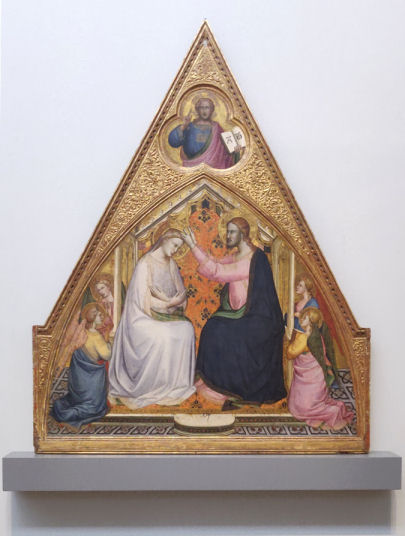
|
|
|
|
|
|
San Gallo
|
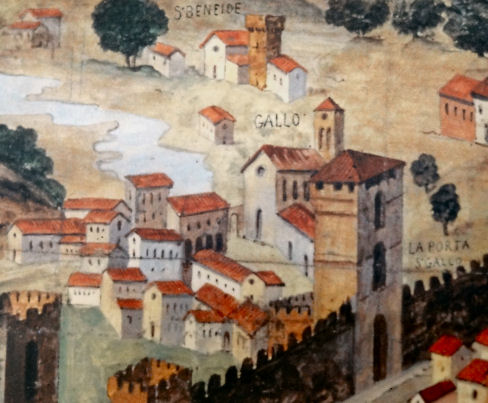
History
A church
dedicated to hermit monk Saint Gallen had existed here since 1218. In
the 15th century the church passed from Franciscans to the reformed Augustinians at
the instigation of
Lorenzo de 'Medici who got the architect Giuliano Giamberti to expand the
church and monastery. Work on the new building was underway by 1488 and
reported as 'almost finished' in 1493. This work so impressed Lorenzo that he, as reported
by Giorgio Vasari, nicknamed the architect Sangallo, and thereafter his Giamberti
descendants kept the name da Sangallo. This was the one major
ecclesiastical commission that Lorenzo financed himself. The complex was
demolished during the siege of Florence in 1529-1530, as were most
buildings outside the walls, so that the attacking armies of the Holy
Roman Emperor Charles V couldn't use them for refuge or supplies.
Charles, in league with the Medici Pope Clement VII, was intent on ending
the Florentine Republic for the last time and re-installing the Medici,
and succeeded.
An early-14th-century inventory lists a 'little old church with an altar
and a sacristy next to the said church and a bell tower with four large
bells' and 'another new church near to the old church with the piazza in
between. In the detail from the Catena map of 1471-80 (see right)
the old church must be the building to the right, under the word GALLO,
with the new church's portico, it is presumed, to the left.
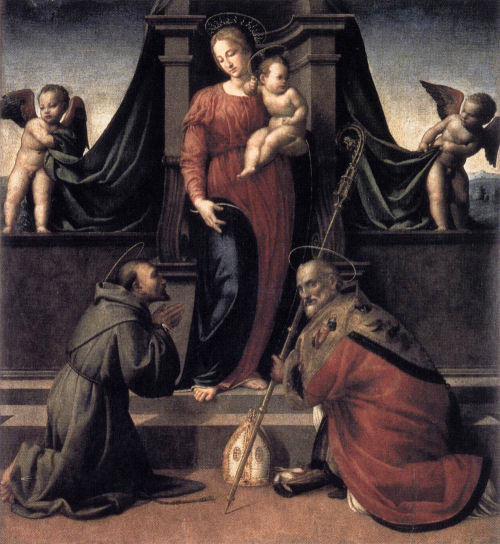 Lost art Lost art
Fra Bartolomeo's Lamentation was painted for San Gallo, moved
to
San Jacopo tra Fossi, and is now in the Palatine Gallery in the
Palazzo Pitti.
The Noli me Tangere by Andrea del Sarto
(see right), is one of three altarpieces that he painted around
1510 for
San Gallo. It too was moved to
San Jacopo tra Fossi, and is now in the museum in the refectory at
San Salvi,
which also houses Andrea's famous Cenacollo. The other two were
a Disputation on the Trinity (widely thought by his contemporaries
to be one of his masterpieces) and an impressive and architectural Annunciation,
with the angel unusually on the right, both now in the Pitti.
The Annunciation, having been initially commissioned by Taddeo di
Dante da Castiglione for
San Gallo, moved to another chapel
belonging to the same family in
San Jacopo tra Fossi, before Maria Magdalena of Austria
had it brought to decorate her bedchambe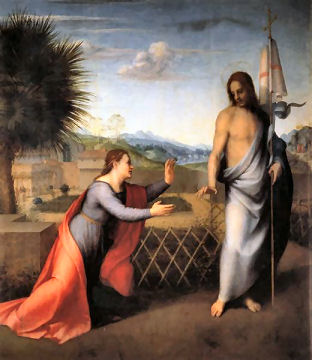 r at the Pitti in 1627. r at the Pitti in 1627.
The Virgin and Child with Saints Francis and Zenobius (1510) by
Francesco Granacci (see left) from the Gerolami chapel here, is
now in the Accademia, where this prolific artist, the son of a mattress
maker, apprentice to Ghirlandaio and friend of Michelangelo, has quite a few works in the early rooms.
|
|
San Giovanni Evangelista
History
The church of a convent founded by the Vallombrosan nun Umiltà
(Humility or Humilitas) of Faenza in 1282. She is said to have founded the
Vallombrosan female order and died here in 1310. The complex was
demolished during the siege of Florence in 1529-1530, as were most
buildings outside the walls, so that the besieging armies of the Holy
Roman Emperor Charles V couldn't use
them for refuge or supplies.
Much of its surviving art depicts Umiltà with a
weasel, the enemy of the serpent, symbol of evil. This animal was replaced
as her attribute in later art by a book, and that too vanished in
Counter-Reformation depictions, in which she becomes a generic
saint without distinguishing symbols
(On the Chain Map)
http://www.umilta.net/umilta.html
Lost art
All but two of the panels from the Altarpiece of the Blessed
Humilitas by Pietro Lorenzetti are in the Uffizi. The other two, depicting Saint
Humility Cures a Sick Nun and The
Ice Miracle of Saint Humility are in the Gemäldegalerie in Berlin. In
the Uffizi the central panel shows the Blessed Humility and the predella
panels show eleven stories from her life. Vasari said that it was by Buffalmacco.
San Girolamo delle Poverine
photo flo sept 2012 thurs 1346 and
entry for Sant'Onofrio di Fuligno in West
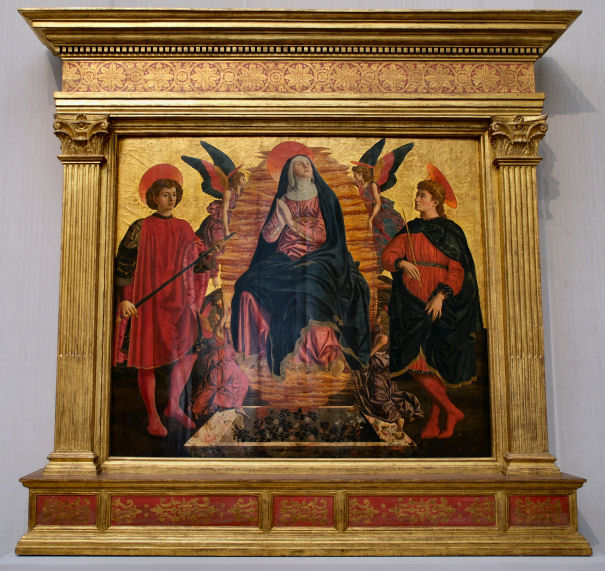 |
|
San Giusto alle Mura
History
This Gesuati church and monastery was just
outside the Porta a Pinti, a northern gate, and named for Saint Justus,
the 4th-century bishop of Lyons, an arm relic of whom was kept in the church.
The Gesuati, a mendicant order founded by Giovanni Colombini from Siena in 1367, were
famous here for the manufacture of pigments and coloured glass and they
became skilled makers of stained glass as well as suppliers of pigments to
Florence's principle painters, including Leonardo and Michelangelo, the
latter buying blue for the Sistine Chapel ceiling.
The church was designed by Antonio do Giorgio from Settignano, Vasari
tells us. He also mentions a tramezzo screen with a carved Crucifixion
group by Benedetto da Maiano with a walnut-wood singing gallery over the
screen and another one over the church entrance. The convent had two cloisters frescoed by Perugino,
along with altarpieces and stained glass. All was demolished before the siege of Florence on 7th October
1529, as were most buildings outside the walls, so that the expected French
besiegers couldn't use them for refuge or supplies.
Perugino's links with the Gesuati order helped with his establishment of a
studio in Florence in 1486, shared with the sculptors Vittorio and
Buonaccorso Ghiberti in the building where Lorenzo Ghiberti had cast his
Gates of Paradise. The contract for the studio had been brokered by a
friar from San Giusto.
Lost art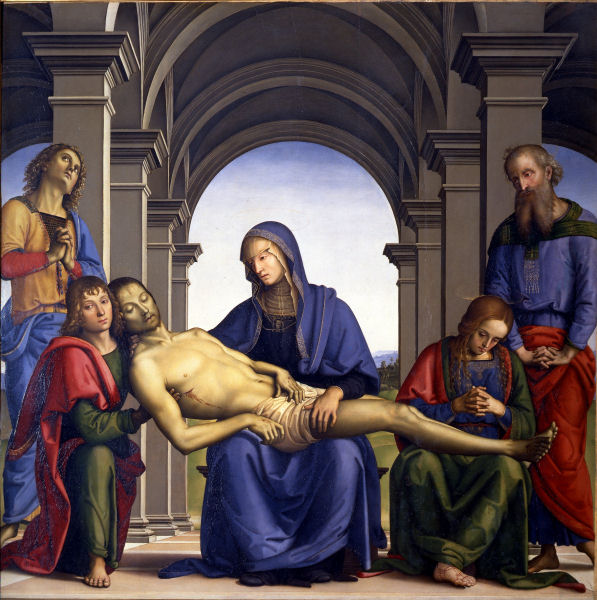
Perugino's calm Pietà and his The
Agony in the Garden were painted c. 1493-96 for altars in the tramezzo of this church. The Pietà
(see right) is notable for its lavish use of
expensive ultramarine, a pigment which the prior here was said to have
been skilled at preparing. Following demolition both were taken to
San Giovannino della Calza near the Porta
Romana, but have ended up in the Uffizi.
Also in the Uffizi, having been in
San Giovannino in between too, is
Domenico Ghirlandaio's high altarpiece for the church here from c.1479.
The main panel has the Virgin and Child Enthroned with Saints Michael,
Justus of Volterra, Zenobius and Raphael. Of the predella panels,
which had been detached and sold by 1828, the Detroit Institute of Arts
and the National Gallery in London have one each, and the Met in New York
has three. These panels are often given to Davide Ghirlandaio, the
brother. The Tuscan government stopped the main panel getting sold to the
London National Gallery in 1855 and so it was bought in 1857 by the Grand
Duke for the Uffizi.
San Gregorio alla Pace
History
The church of San Gregorio della Pace was founded in 1273 on land owned by
the Mozzi bankers at the behest of Pope Gregory X to commemorate the
illusory peace then achieved between the Guelphs and the Ghibellines.
Passing to Bardi patronage, the adjoining convent of the Belmorire Fathers
(Camillians) followed in 1600 and was enlarged, funded by Rodolfo Bardi.
It was suppressed in 1775 and the complex returned to the Mozzi who in
1880 they put it up for sale. It was bought by the antiquarian Stefano
Bardini, and rebuilt between 1881 and 1883, based on a design by Bandini
and the architect Corinto Corinti. The complex, including the Palazzo
Mozzi too, still houses the Museo Bardini and restoration facilities,
incorporating the church.
San
Miniato fra le Torre
History
An ancient church, built where the
Florentine martyr San Miniato was said to have been beheaded, near the
Roman forum, in the area now occupied by the central Post Office.
This church was called "among the towers", to distinguish it from the
other church dedicated to the saint, because in this area, before the 1894
demolitions, there were many tower houses.
Early authors report that an antiphonary
kept in the sacristy here claimed that the church had been founded in 507,
by an otherwise unknown Pope Pelagius. More recently authors place its
foundation between the 8th and 11th centuries. It is first documented in
1046. In the 15th century the orientation of the church was reversed, with
the altar made to face west, but most of the old fabric was retained.
After renovation in the 18th century the church was suppressed in 1785,
converted to private accommodation, and demolished in 1894, during the
redevelopment of the Mercato Vecchio area.
Lost art
The Assumption of the Virgin Between
Saints Minias and Julian (see left) from 1449-50, painted by Andrea
del Castagno for the high altar here, now in the Gemäldegalerie in Berlin.
It is the only example of the art and fixtures of this church to have been
traced.
|
|
San Niccolò di Cafaggio |
|
San Pier Buonconsiglio
|
|
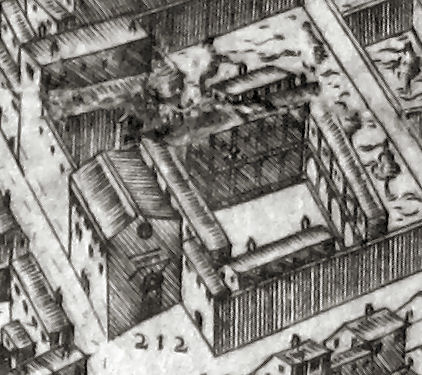
History
A Benedictine convent built by
Niccolò Gianfigliazzi in 1340 and suppressed in 1783. It stood on what is
now the via degli Alfani and was named for the Cafaggio area, which then
was woods. Also called San Niccolò in via del Cocomero, for the previous
name of the current via Ricasoli. The remaining convent complex now houses
the Opificio delle Pietre Dure and the Academy of Fine Arts.
Lost art
A high altarpiece polyptych by Bicci di Lorenzo, with the help of Stefano
d’Antonio di Vanni, from c.1433, dismembered a sold off in 1787. The
central panel of the Virgin and Child with Four Angels is now in
the Galleria Nazionale, Parma. It was flanked on the left by a panel
depicting Saints Benedict and Nicholas of Bari now in the Museo del
Monumento Nazionale della Badia Greca, Grottaferrata (this panel is
ascribed to Stefano d’Antonio) and on the right by a panel representing
Saints John the Baptist and Matthew, now in the Met in New York. The
predella probably had seven panels of the life of Saint Nicholas, of which
six have been identified. These panels are said to be The Birth of
Saint Nicholas (sold at Sotheby’s in July 2009, current whereabouts
unknown), The Miracle of a Child Restored to his Parents (up for
auction, Dorotheum 10th November 2020), Saint Nicholas Providing
Dowries and Saint Nicholas Resuscitating Three Youths (both in
The Met New York), Saint Nicholas Rescuing Sailors in a Storm (Ashmolean
Museum, Oxford), and A Miracle at the Tomb of Saint Nicholas
(Wawel State Collection, Kraków). |
|
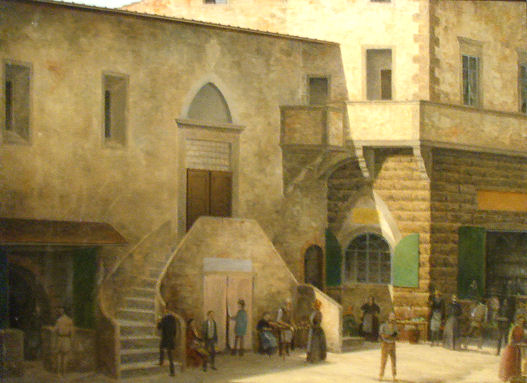
Painted by Fabio Borbottoni. |
|
San Pier Maggiore
Borgo degli Albizzi |
History
Tradition has it that Saint Zenobius, Florence's 4th-century first bishop and later
one of the city's patron saints, had founded
a church here in the 5th century. The first documented mention of the
complex, though, is of a Benedictine convent, founded
in 1067, with Ghisla Firidoli as its first abbess. The abbess traditionally welcomed each new bishop of Florence
upon his arrival in the city, with a ceremony involving putting a ring on
his finger.
She was therefore nicknamed 'the wife of the bishop'.
The Gothic church was built during enlargement in the early 14th
century, being
completed by 1352. It was a large triple-aisled church with the high altar
(upon which would have stood the large altarpiece by Jacopo di Cione
mentioned below) in a large raised choir chapel that was rebuilt 1612-15,
around which time the altarpiece was removed.
After a lot of minor rebuildings it was rebuilt in 1638 by
Matthew Nigetti as seen in the etching and plan (see right).
Among the artists buried here were Lorenzo di Credi, Luca della Robbia, Piero di Cosimo
and Mariotto Albertinelli.
The church was demolished in 1784 having been declared unsafe following a
partial collapse during rebuilding work the year before, which had itself
been prompted by a crumbling column, but only
one, non-load bearing, column had collapsed. Supposedly the real reason
for the demolition was Grand Duke Peter Leopold's desire to minimize the
dominance of religious
institutions in Florence which had been behind his many suppressions.
Three arches of the portico (part of the
1638 rebuilding) of the façade
survive (see photo right), two being occupied by private houses. Art and
fittings from the church were transferred to various Florentine
institutions, including the
Spedale degli Innocenti and the church of
San Michele Visdomini.
Lost art
A marble high relief of the Annunciation
by Arnolfo di Cambio from c.1295/1302 is in the V&A in London. It was
formerly in the cloister here.
An early 14th century painted Crucifix by Lippo di Benivieni is
now in the Santa Croce museum, where it's been since 1785.
The majority of the 12-panel Coronation of the
Virgin high altarpiece of 1370-71, by
Jacopo di Cione (see below), commissioned for this church, probably by the Albizzi family, is now in the National Gallery
in London. The main panel is flanked by two large panels of crowds of
saints, many locally-connected and many still the cause of arguments as to
their identity, but oddly no Benedictine dominance. Above is a substantial group of six panels depicting scenes from
The Life of Christ. The frame is lost and the predella, showing
six scenes from The Life of Saint Peter, and pilaster panels are
now in
other collections. Three of the predella panels are in the Vatican, and
one each are in Philadelphia and Rhode Island.
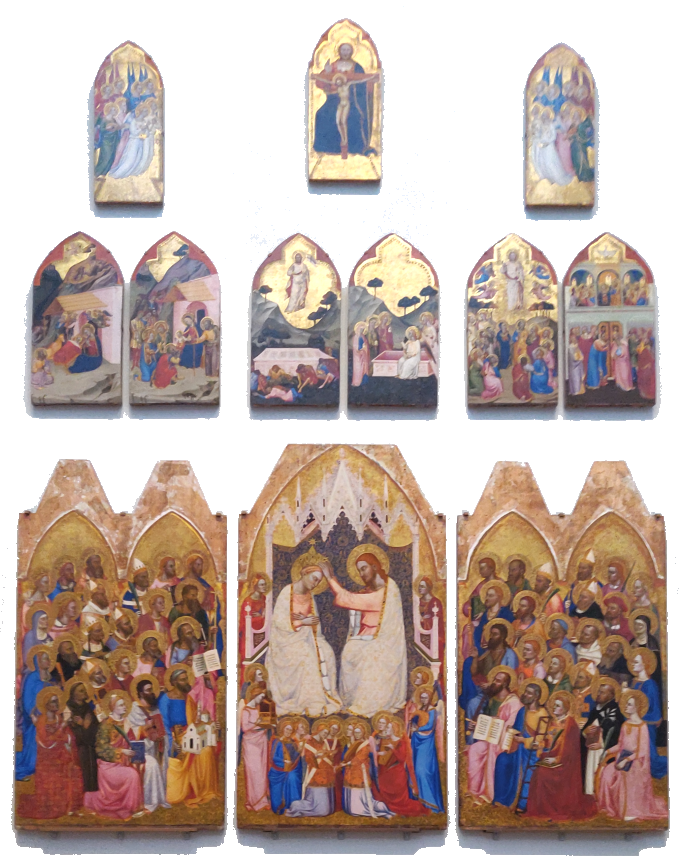
The Assumption of the Virgin of c. 1475-6 by Francesco Botticini, which
was
the altarpiece in the burial chapel here of the humanist and politician Matteo Palmieri,
is now in the National Gallery in London. He and his wife, Niccolosa de‘
Serragli, flank the
apostles who stand around the Virgin's rose-filled tomb in the lower
section. The mixing up of Old Testament figures, future saints and the six
lower orders of saints is said to illustrate Palmieri's heretical writings
- he most oddly thought that humankind descended from neutral angels at the
time of Lucifer's fall. This explains why his face had
been defaced by scratches before recent restoration. His body was also
removed from the church later and an effigy of him burned. The work had been previously
thought to be by Botticelli, due to Vasari confusing their names. In 2015
there was an exhibition at the National Gallery devoted to it, with connections made to
the Jacopo di Cione altarpiece also in the National Gallery. Research
for the exhibition involved trying to reconstruct San Pier Maggiore, and there's a
fascinating film.
Watch it here
The Madonna of the Girdle by Francesco Granacci (1508/9) looks very
Michelangelo-inspired and is now in the Accademia.
The Visitation by Maso da San Friano, a Mannerist altarpiece of
1560 painted for the chapel of the de' Pesci in this church, is now in the
Fitzwilliam in Cambridge UK.
An Annunciation by Giovanni Antonio Sogliani, taken from this
church when it closed in 1783, was installed behind the high altar in the
1910s to replace Ghirlandaio's Adoration of the Magi in the church
of the Spedale degli Innocenti.
The third work from this church in the National Gallery in London is
Saint Zenobius Revives a Dead Boy by Giovanni Bilivert from
c.1610/20. It depicts the same miracle as featured in the works mentioned
below, and also includes a view of the façade of this church. Bilivert,
born in Florence, the son of a Dutch goldsmith, worked for the Medici and
was the most successful pupil of Florentine Baroque artist Lodovico Cigoli.
Bilivert painted this large panel for his friend Giuliano Girolami, who
came from a prominent Florentine banking family who claimed descent from
Zenobius. The family’s coat of arms appears on the clasp of the saint’s
cope.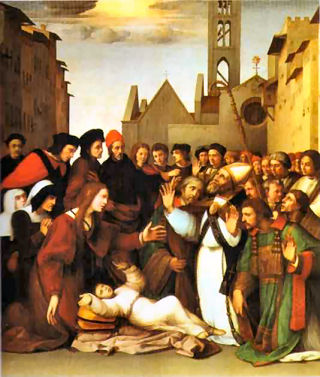
The church in art
Saint Zenobius, the first bishop of Florence, is said to have performed one of his miracles
on a procession from San Pier Maggiore to the Duomo after a cart had run over
a boy, so the church appears
in the background of many paintings of this miracle.
The boy had been put in the care of Zenobius while his mother went on
pilgrimage to Rome. Returning on the day of the accident she took his body
to Zenobius on the procession on the Borgo degli Albizzi and he revived
him.
The original church is visible in the background of Saint Zenobius Raising a Boy
from the Dead (see right) by Ridolfo Ghirlandaio. And
A Miracle of Saint Zenobius by
Domenico Veneziano in the Fitzwilliam, Cambridge UK, part of the Saint
Lucy Altarpiece.
Also Saint Zenobius Resuscitating a Dead Child by Benozzo Gozzoli
in the MET New York. The church in Masaccio and Masolino's Saint Peter
Healing with His Shadow fresco in
the Brancacci Chapel may also be,
somewhat appropriately, San Pier Maggiore.
There's a late 19th century view painting by Fabio Borbottoni of this
church.
|
|
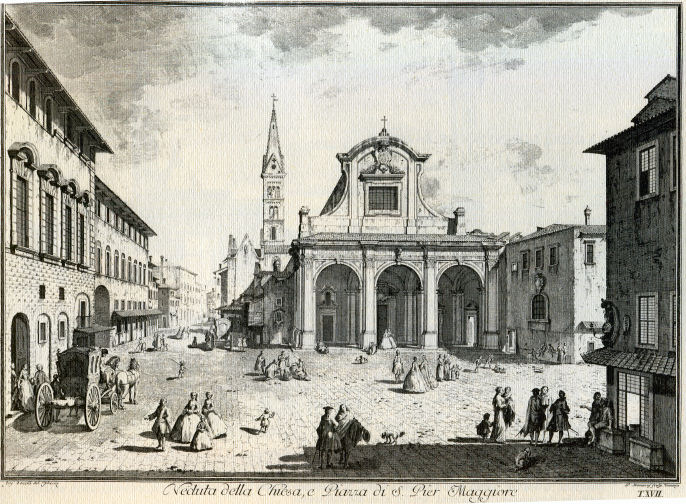
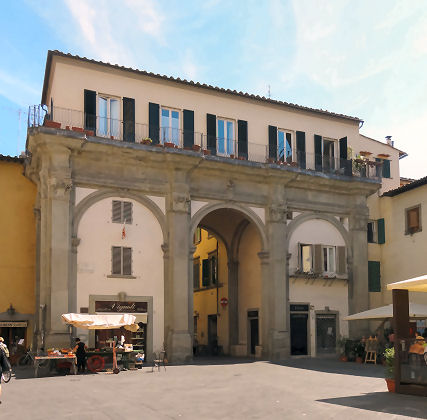
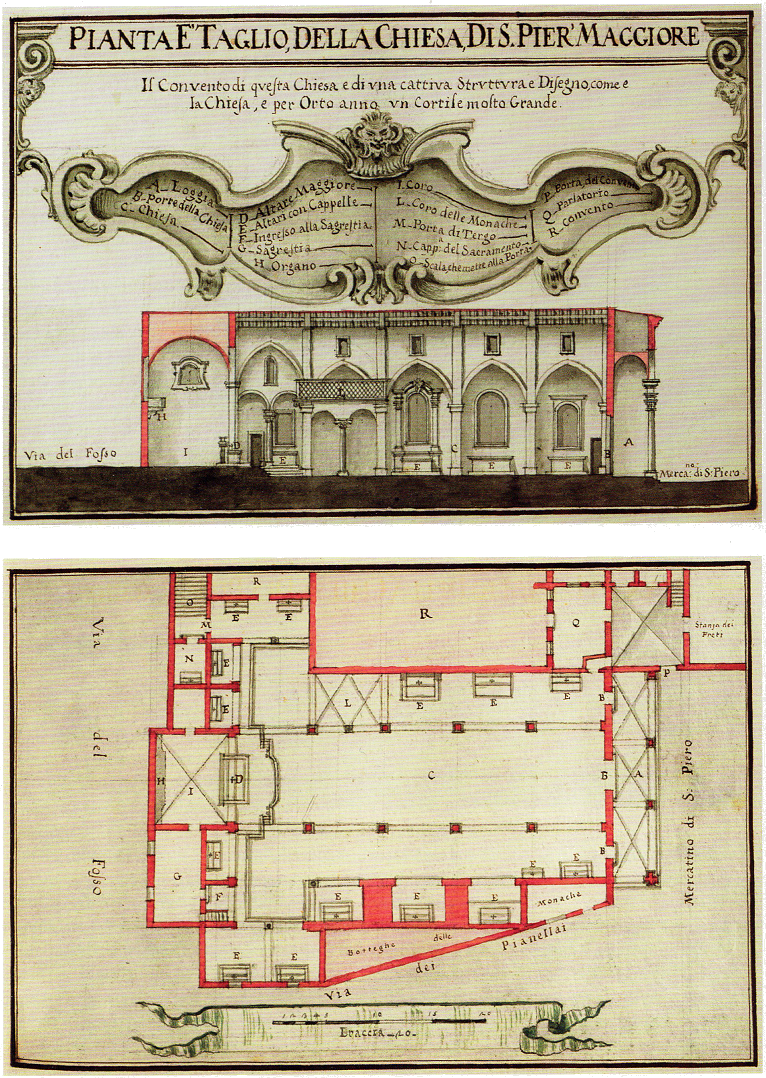
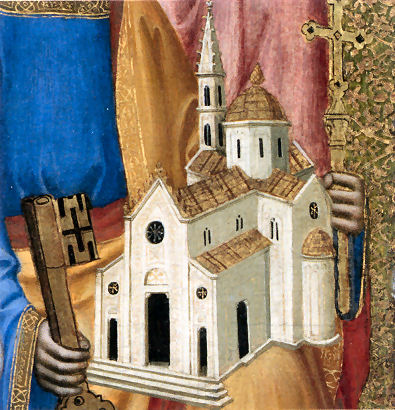
The original 14th-century church as held
by
Saint Peter in the Jacopo di Cione altarpiece.
|
|
San Pier Martire
via dei Serragli |
|
History
The church and convent was founded in March 1417, although some
claim the was a church here by 1312. It was the first
nunnery founded by the Observant Dominicans, who were keen to return to
the order's original values. The complex, the first in Florence to be
dedicated to one of the order's most illustrious preachers - who had
preached in Florence in 1244 - benefited from the patronage of humanist statesman Niccolò da Uzzano and was built
in the former palace of Niccolò
Buondelmonte. Two experienced nuns were sent to educate the new nuns here
in 1419.
They came from San Domenico in
Pisa, the same house that had helped set up, and remained closely
connected with, the Observant Dominican
Corpus Domini in Venice. Amongst the first nuns where Margherita deli
Spini and Maddalena di Bartolommeo degli Usimabardi, both from prominent
and wealthy families and both of whose name saints feature in the early Fra
Angelico altarpiece soon commissioned, so encouraging theories that they
were the major donors.
In 1557 the monastery was closed and demolished to make
way
for the fortifications around the San Pier Gattolino gate. The nuns here moved to
San Felice in Piazza,
taking their Fra Angelico altarpiece (see below) with them.
Lost art
Fra Angelico painted the high altarpiece for the church
of the monastery, called the San Pietro Martire Altarpiece, c.1421/2
(see right). The
main panel, The Virgin and Child
with Saints Dominic, John the Baptist, Peter Martyr and Thomas Aquinas is now in the Museum of
San Marco. In the roundels are the Annunciation and God the
Father, with scenes of Peter Martyr preaching and his assassination in
the spandrels. The three predella panels are in the Courtauld Institute in London.
They make up seven roundels - the central trio show Christ as the Man
of Sorrows
flanked by Saint Mary Magdalene
and Saint John the Evangelist
with flanking pairs of female saints - Saints Catherine of
Alexandra and Agnes and The Blessed Margaret of Hungary
(Saint Catherine of Siena?)
and Saint Cecilia(?).
There's also a painting by Gherardo di Giovanni del Fora in the Bowdoin
College Museum in Maine of Saints Mary Magdalene, Peter Martyr and
Catherine of Siena (c. 1475) that may well have been painted for the
convent here,
not least because of its choice of saints.
|
|
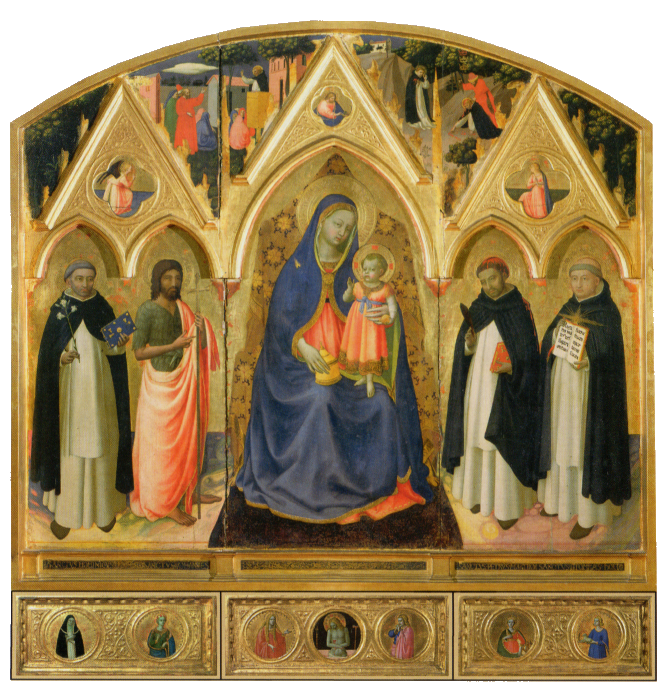
|
|
San Pier Scheraggio
Via della Ninna |
|
 History History
A Romanesque basilica, consecrated in 1068,
restored in 1294, and reconsecrated in
1299, which had been used up until the construction of Palazzo Vecchio in 1313
for the City Councils of the Florentine Republic, at which Dante (who lived
nearby) and Boccaccio were amongst the speakers. The arches of the left nave,
destroyed in 1410
when Via della Ninna was enlarged,
are visible from the street (see photo left).
The church takes its name from the schiaraggio, or drain that ran beside
the city walls.
Giorgio Vasari, when he began work on the Uffizi
in 1560, demolished/incorporated the church into the building.
After the confiscation of ecclesiastical
properties carried out by the Lorena in 1743, the church was deconsecrated,
partially demolished and partially incorporated into the Uffizi 1782. The nave
still exists and was restored in 1971 but is not open to the public. The
church's hall is used to display detached frescoes, including
several from this church and Andrea del Castagno's series of
Famous Men from Villa Carducci at Legnaia, (including Danta and Boccaccio) of
around 1450. Also fragments of Roman-period decorations of a room that is
thought to have been a tavern, discovered under San Pier Scheraggio during
the 1971 restoration work.
Francesco d’Angelo (1446-1488), also known as Il Cecca, a Florentine sculptor
and engineer, best known for his sculptures - often mechanical - carried in
religious processions, theatrical machinery, and military devices. He was killed
in battle in 1488 while accompanying the Florentine army and was buried here.
A new ticket-checking post in the Uffizi is in a room
revealing some brickwork, decoration, the floor and some pillars of San Pier
Scheraggio (see photo right), behind glass.
Villani said
In his Chronicles Giovanni Villani says that Florence was constructed in
the image of early Christian Rome, with the position of its churches reflecting
the pilgrimage churches of Rome. He claims that this church stood in for Old
Saint Peter's.
Lost art
There were once frescoes by Cimabue in the nave, it is said.
Giovanni dal Ponte's San Piero Scheraggio predella, of around 1430,
is now in the Uffizi.
A late-12th-century pulpit, disassembled during the transformations carried
out by Vasari in 1570, went to San Leonardo in Arcetri in 1782.
Ridolfo Ghirlandaio's Virgin and Child with Saints Julian
and Sebastian was transferred from here to San Martino della Scala in the
early 19th century.
A Presentation in the Temple painted by Poppi for this church was
mocked by Borghini because he thought that the prophetess Anna looked too young.
The church in art
Vasari's The Procession of Pop Leo X through the Piazza della Signoria,
a ceiling panel in the Palazzo Vecchio, has this church in the centre-left
background, as does a painting of Savonarolla getting his comeuppance which is in the Pitti
Palace's Gallery of Modern Art. And an even
better view of the church's façade appears in a late-19th-century painting by Fabio Borbottoni (see detail
left) |
|
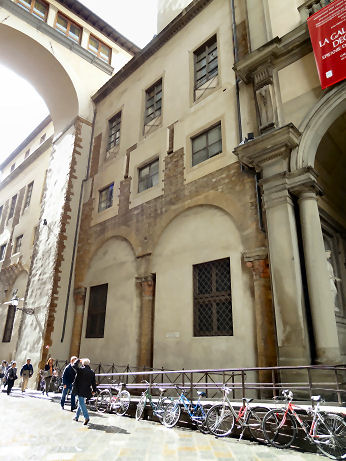
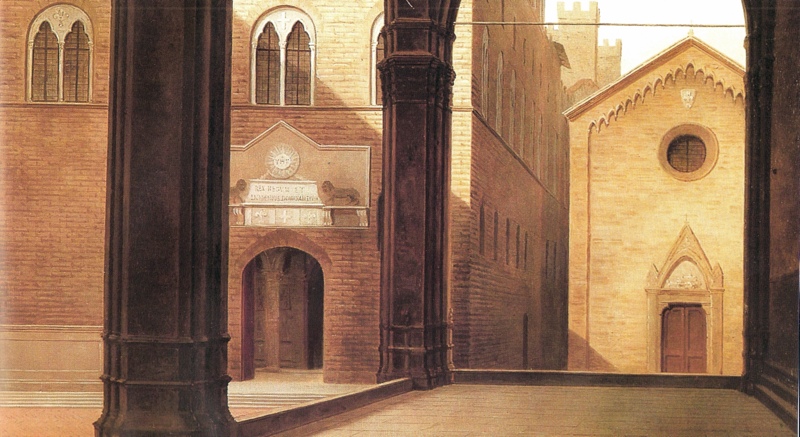 |
|
San Romolo |
|
San Ruffillo |
|
.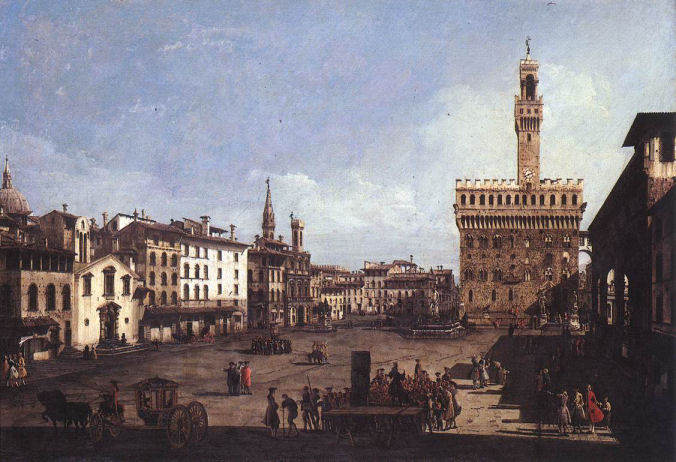
In this painting of the Piazza della Signoria by Bernardo Bellotto San Romolo
can be seen on the left.
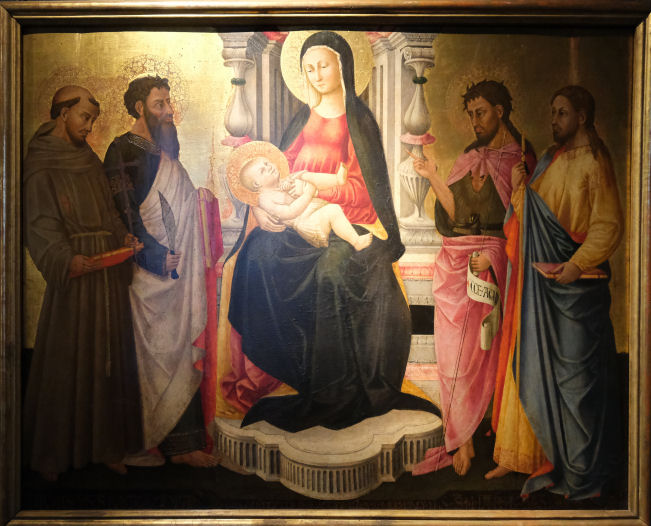
Lost art
The high altarpiece was The Virgin and Child
Enthroned with Saints Francis, Bartholomew, John the Baptist and James by
Neri di Bicci from the 1440s, now in the National Gallery in the Pilotta Complex
in Parma.
|
|
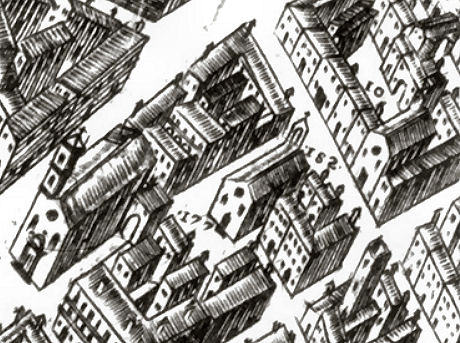
History
First documented in 1077 and named for the bishop saint of Forlimpopoli. It
first faced the small Piazza Cavallari, but in 1620 was reorientated with its
entrance on the Piazza dell'Olio.
With the suppressions of 1785 it was put to residential use and then demolished
in 1823.
Lost art
Pontormo's fresco of a Sacra Conversazione, now in
Santissima Annunziata.
San Ruffillo is in the centre, before its
reorientation,
with
San Salvatore al Vescovo to its right and
Santa Maria Maggiore
to the left. From the 1584 Buonsignori Map
|
|
San Tommaso |
|
History
Originally built in the 13th century by the Sizii family. The church was in Piazza del Mercato Vecchio, before the clearance of the
Mercato and the Florence Ghetto to
make room for the Piazza Vittorio Emanuele II, today called the Piazza della
Repubblica. The site of the church, on the north-east corner of the Piazza,
is now the Hotel Savoy.
The 1926 postcard (below right) produced by architect Corinto Corinti
shows the
the façade of the 13th century church 'compared to the bulk of the building
of the Savoy Hotel. The change in scale and character of the building is
evident: the articulated and picturesque facade of the old church... gives way
to a pretentious and massive building, destined for privileged users.'
The church in art
The church appears in at least two
late-19th-century view paintings by Fabio Borbottoni (see below), he
having painted much of the Mercato Vecchio just before it was demolished.
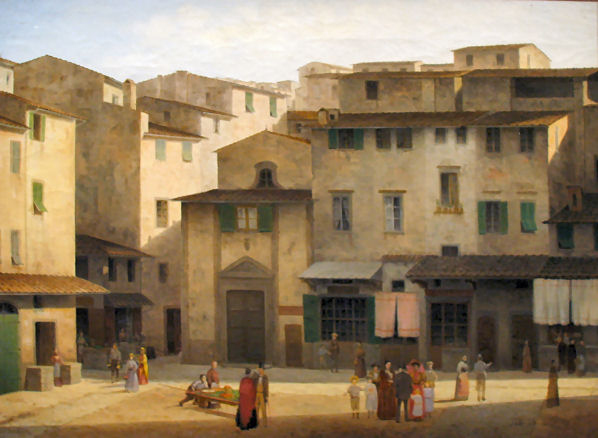 |
|
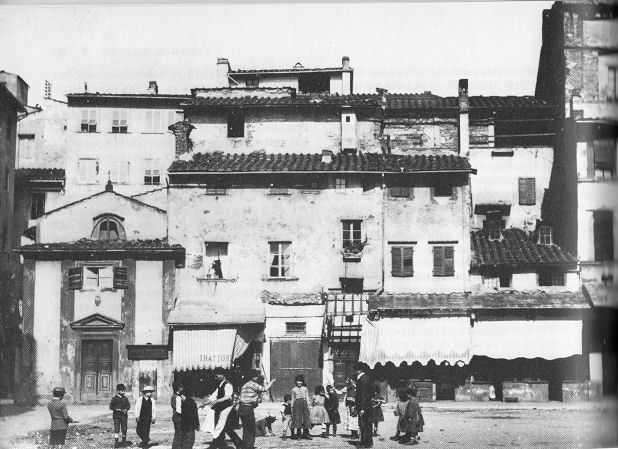
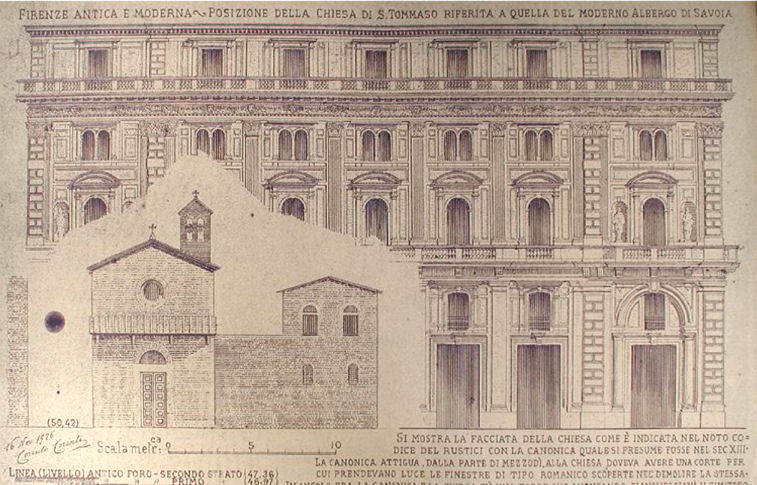
|
|
Sant'Andrea |
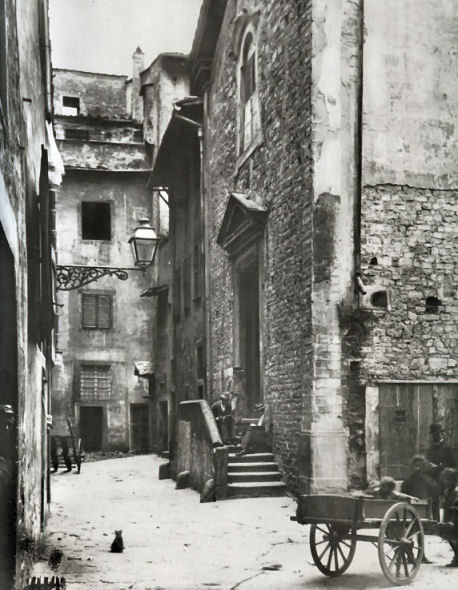
History
A church had been here since the early 9th century, with a convent dedicated to the Virgin.
Around the year 1000 the nuns moved to San Martino a Mensola and were
replaced by Cluniac monks. In 1013 Bishop Ildebrando gave the complex to
the new abbey of San Miniato al Monte and in 1205 the buildings were
passed on to secular clergy by Bishop Lamberto.
By the 14th century the Elisei family were
patrons. The church was damaged by fires in 1232, 1304 (during
conflict between rival families) and 1601, resulting in restorations. More
restoration followed in the 18th century, including the façade.
Suppressed in 1765 and later disgracefully demolished. The church stood on
the corner of Calimala and via Pellicceria
before the clearance of the area to make room for the Piazza Vittorio
Emanuele II, today called the Piazza della Repubblica.
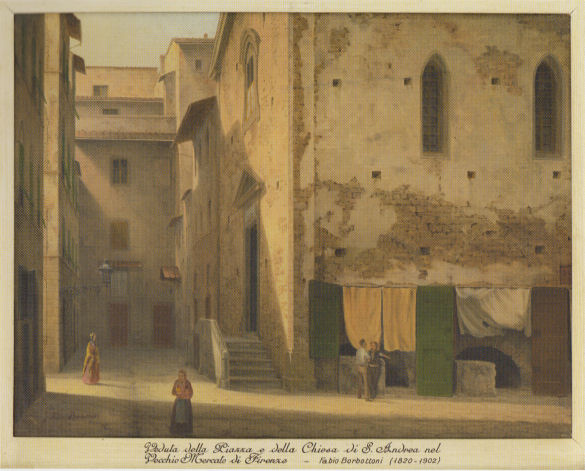
Interior
The church had three altars. The one on the left had an
altarpiece by Vasari, but we don't know who painted the one on the right.
The high altarpiece was by Domenico Ghirlandaio.
Campanile
Had been used to house pigeons for a while, with the bells
transferred to a more modern tower. The original, somewhat squat, tower
was probably 11th century
The church in art
The church appears in at least four
late-19th-century view paintings by Fabio Borbottoni (see one of them left),
he having painted much of the Mercato Vecchio just before it was
demolished.
The 1927 postcard (below) was produced by architect Corinto Corinti.
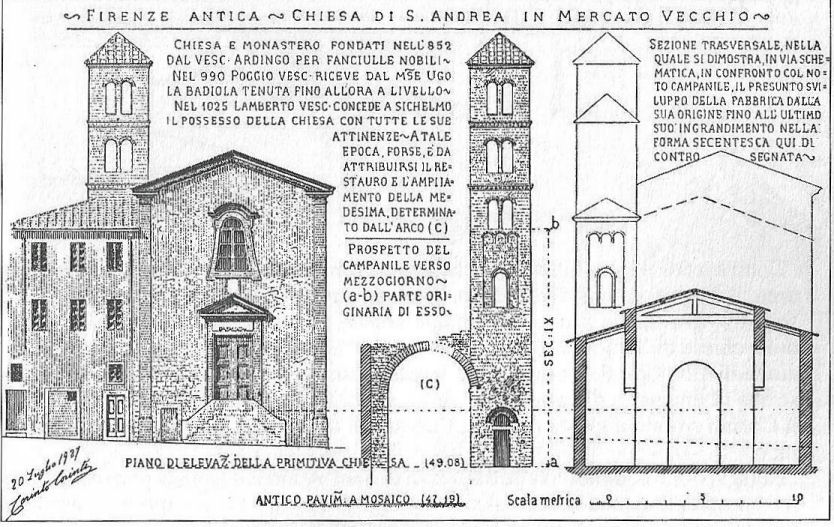
|
|
Santa
Cecilia
Piazza della Signoria |
|
History
Opposite the Palazzo Vecchio, built
in 1341 where there had been a church since the 9th century, although the
first documented mention dates to 929. The previous church had been burned
down by the same fire which
burned down Orsanmichele, along with the rest of the centre, on June 10, 1304. Moved in 1367 to enlarge the piazza. Suppressed in 1783 and
later demolished. The site of the church is now
the
Palazzo Lawison(?)
The church is remembered in the naming of the small Piazza di Santa Cecilia
behind.
Lost art
Saint Cecilia and Eight Stories from her Life by the Saint Cecilia
Master (see right). This altar frontal, from the church of Santa
Cecilia, is today generally dated shortly after 1304; it is the work of an
anonymous master who may have worked with Giotto at Assisi. Vasari thought
that it was by Cimabue. It's now in the
Uffizi.
An altarpiece of 1641 by Francesco
Curradi of The Death of Saint Cecilia now in Santo Stefano al Ponte.
The church in art
A painting by Giuseppe Zocchi called Piazza della Signoria of
c.1741, now in a private collection, shows Santa
Cecilia to the right (see
detail right). I think that it must be the second doorway beyond the
archway, under the bell tower. In the late 19th century a very similar view was
painted by Fabio Borbottoni.
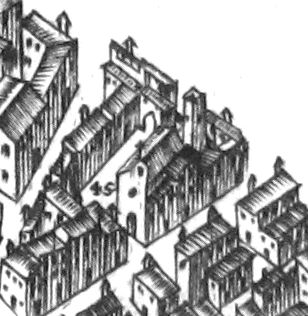
From the 1584 Buonsignori Map.
|
|
 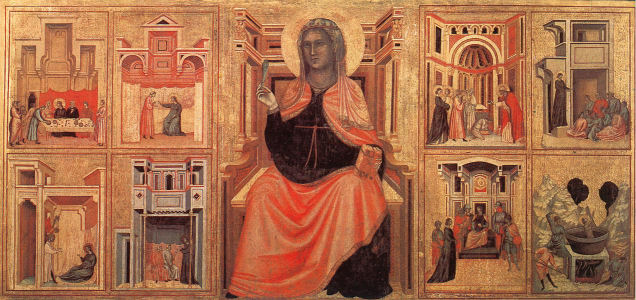 |
|
Santa
Maria degli Ughi
Piazza Strozzi |
|
Santa Maria delle Campora |
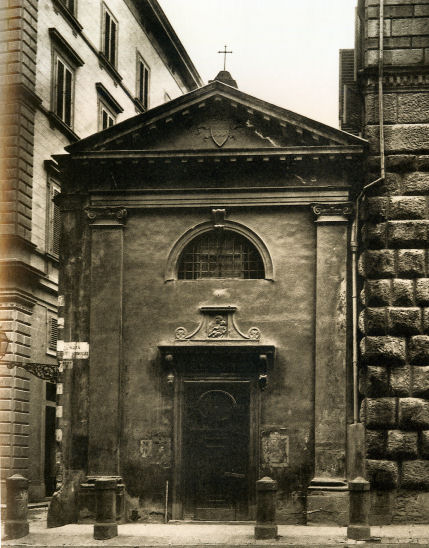
History
The church was founded
in the ninth century and
was perhaps
best known for its bell,
which rang at three in
the morning to signal
the finish of work in the Old Market. It
also famously rang on the night
of 11 December 1529, during
the siege of Florence,
signalling the sortie of the
Florentine militia. During
construction of Santa
Maria del Fiore, the
church of Santa Maria
degli Ughi functioned as the
cathedral. The
Ughi were
one of the oldest families in
Florence and also gave their name to Montughi
at Careggi, where they
had the country estate.
The church
was deconsecrated in 1785
and was later used
by the Strozzi as a private
chapel. It was demolished in the late
nineteenth century as part of
the demolition of the Old Market
area. The Palazzo
Mattei stands on the site of the old
church.
The church in art
Two view paintings by Fabio Borbottoni (1820-1902) of Piazza delle Cipolle
(as the Piazza Strozzi was then called)
show the Strozzi Palace on the left and this church on the right.
|
|
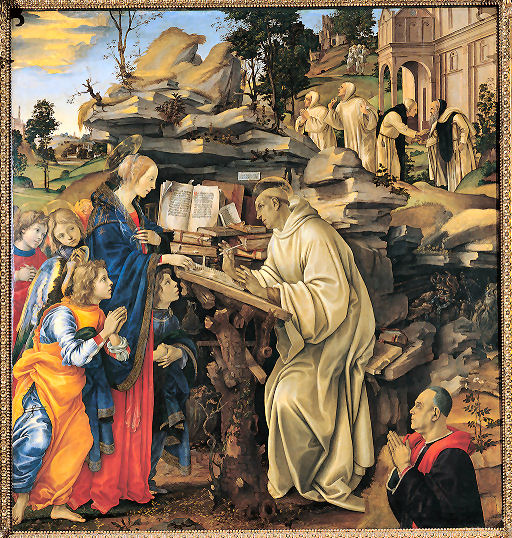
History
A Benedictine priory church standing just outside the Porta Romanai, this church had a
'very beautiful' choir of walnut decorated with intarsia work. It was
another church that was outside the city walls and was demolished in
advance of the Siege of Florence in 1529/30 by the armies of the Holy
Roman Emperor Charles V who, in league with the Medici Pope Clement VII,
was intent on ending the final Florentine Republic and re-installing the
Medici; and succeeded.
Lost art
Filippino Lippi's 1485-87 The Virgin Appearing to Saint Bernard
of Clairvaux (see below), was taken by the Benedictines to the del Pugliese family chapel in the Badia
when this church was demolished, having been originally painted for the
del Pugliese family chapel here. The Vision... is an episode
from Bernard's life popular in Florence but rare elsewhere in the main
field of altarpieces. The Accademia has
a Coronation of the Virgin Surrounded by Saints and Angels by Rossello di Jacopo Franchi.
|
Santa Maria della Neve
The Murate
Via Ghibellina |
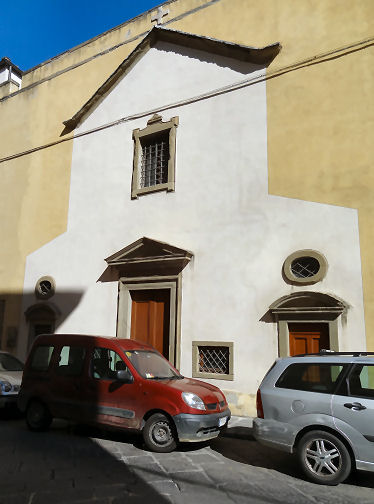
History
Built as the Santissima Annunziata alle Murate and Santa Caterina
convent from 1439 for the Benedictine nuns who had moved from crumbling cells (murate
means 'walled up') on the Rubaconte Bridge, which was where the Ponte
alle Grazie is now. The most substantial of these structures was the bankside
oratory of
Santa Maria della Grazie. A poor woman called
Apollonia had first walled herself into
a small house on the second pier on the bridge in 1390. She was joined by
other women and in 1413 they were pressured into becoming Benedictines and
called Le Romite dell'Annunziata. In 1424 there were thirteen women and
they moved to a house on this site. At first the parish and Benedictine convent of Sant'Ambrogio placed restriction on the size, number of chapels and use of
the church here, called Santa Maria della Neve. But in 1434 a papal
bull disconnected the convent from the parish and allowed the abbess more
autonomy. So there were soon plans to enlarge the convent buildings to
accommodate the growing number of nuns, now numbering thirty-six.
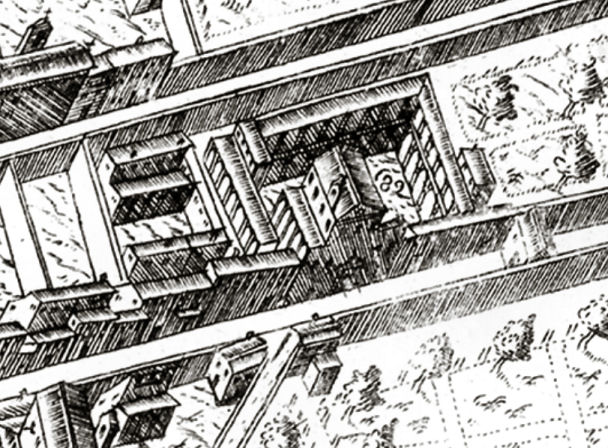
Work was
underway when Giovanni D'Amerigo Benci approached the abbess, Scholastica
Rondinelli, with a view to endowing a chapel. Benci, a manager at the Medici bank, was Cosimo de' Medici's most trusted deputy and, following his
return to Florence in 1435, was to become the convent's major early
patron. He initially undertook the financing of three altars for the
church, with altarpieces by Filippo Lippi, as detailed in
Lost art below. Then in the late 1440s/early 1450s he paid for considerable expansion
and rebuilding to house the now exceeding one hundred nuns. His
granddaughter Ginevra, the subject of a famous Leonardo portrait, stayed
here before her marriage and may have
been a tertiary and retreated here (there is controversy). But when she
died c.1520 she was vested as a nun and
buried here, of that there is no doubt. That the Leonardo portrait spent
some years after her death in the Murate is also arguable.
The complex was further renovated and expanded first in
1471, after a fire, and in 1571 following a flood, this latter rebuilding having
provided the church with it's most recent façade, traditionally(!)
ascribed to Michelangelo. Documents show
that Lorenzo de' Medici financed the early 1470s construction work, but
coats of arms and such announcing his involvement were consciously
avoided. The wealth and connections of the women associated with The Murate was
probably what led to Savonarolla's condemnation of the convent in 1495. Caterina de'Medici stayed here from 1528 to 1530 when Queen of
France and, after the death of Cosimo I in 1574, so did Camilla
Martelli, his second wife. Also the illegitimate daughters of Don
Pietro de 'Medici.
Suppressed by the French in 1808, the convent was rebuilt by the
architect Domenico Giraldi in 1845 and turned into a prison after the
closing of the nearby Stinche and the Bargello in the mid-1800s, which it remained until 1985. During
World War II the prison became notorious for the imprisonment and
torture of partisans captured by the fascists. Much damage to the church during
the flood of 1966, with prisoners having to be rescued by locals. In 1974
the crumbling and overcrowded prison saw rioting and, of course, prisoners
climbing onto the roof.
Following the building of the new lily-shaped Solliciano prison in the
mid-1980s the Murate has been jazzily restored and transformed into housing
units, shops, studios, and restaurants, with pedestrian spaces and a piazza named
after the chapel of Santa Maria della Neve. The plans were drawn up by
Renzo Piano in 1998 and the complex opened in 2011. It's now called the
Murate Art District, or MAD. Photos online of a
restaurant called Fishing Lab show mouth-watering fresco patches.
Some prison cells have been preserved.
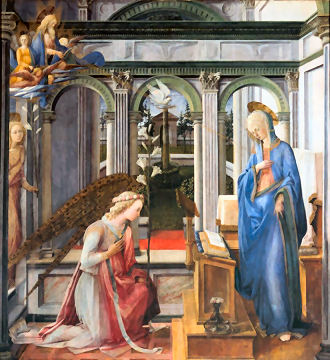
Miracle-working images
An image of the nursing Virgin was said to have cured a nun's
illiteracy when she prayed before it. The convent also possessed a
similarly miraculous Annunciation in the sacristy, said to have
been the painting brought from the church on the Ponte Rubiconte and now
lost, and a Crucifixion
by Neri di Bicci.
A marble relief called the Madonna della Neve, attributed to
Desiderio da Settignano or Donatello, floated out of the medical
dispensary during a flood and came to rest in an orchard. This was
interpreted as showing that the image was desirous of a more place
of display. The image was placed in the convent walls before Duke
Alessandro de' Medici took responsibility for the image and had the
oratory, with no internal passage to the nunnery, built to house it
Lost art
A Filippo Lippi Annunciation (c.1443) (see left)
features a young angel in the doorway to the left, said to represent an
angel who regularly appeared to the nuns here. It was painted for the high altar in the church, is now in the Alte Pinakothek in Munich. Lippi painted three altarpieces for this church, another
was dedicated to Saint Bernard and is reported to have been destroyed in a
flood in 1547. However it has been suggested that a very
damaged panel in the
MET museum in New York depicting Saints Augustine and Francis, a Bishop
Saint, and Saint Benedict might be a surviving fragment from this
second altarpiece. Both works by Lippi were financed by Giovanni
d’Amerigo Benci, using his boss Cosimo de'Medici's favoured artist. The
third was a Crucifixion, now lost.
There's a Raphaelesque Virgin and Child by Ridolfo del
Ghirlandaio, now to be found in the Sant'Onofrio di Fuligno refectory
which was originally in the convent here.
The Last Supper by Giorgio Vasari, on five wooden panels, was moved from here to
San Marco
after suppression, and to the Castellani Chapel in Santa Croce in 1815. In
the 1880s it was moved to the former refectory there, after it was decided
to make it a museum. It was much damaged during the 1966 flood, having remained
submerged for 12 hours, and underwent restoration (funded by the
Getty Foundation) from 2010 at the Opificio delle Pietre Dure. It had
been put into storage after the flood due to a lack of funds, a situation
exposed by Marco Ferri in November 2003. The restoration was completed and
the restored painting was returned to the refectory at Santa Croce in
2016.
Vasari also made a painting of The Annunciation for the
Murate, in payment for his sister's dowry here. He wrote that he had maybe
made the Virgin look a bit too terrified.
|
|
Santa Maria della Pace |
|
Santa Maria in Verzaia |
|
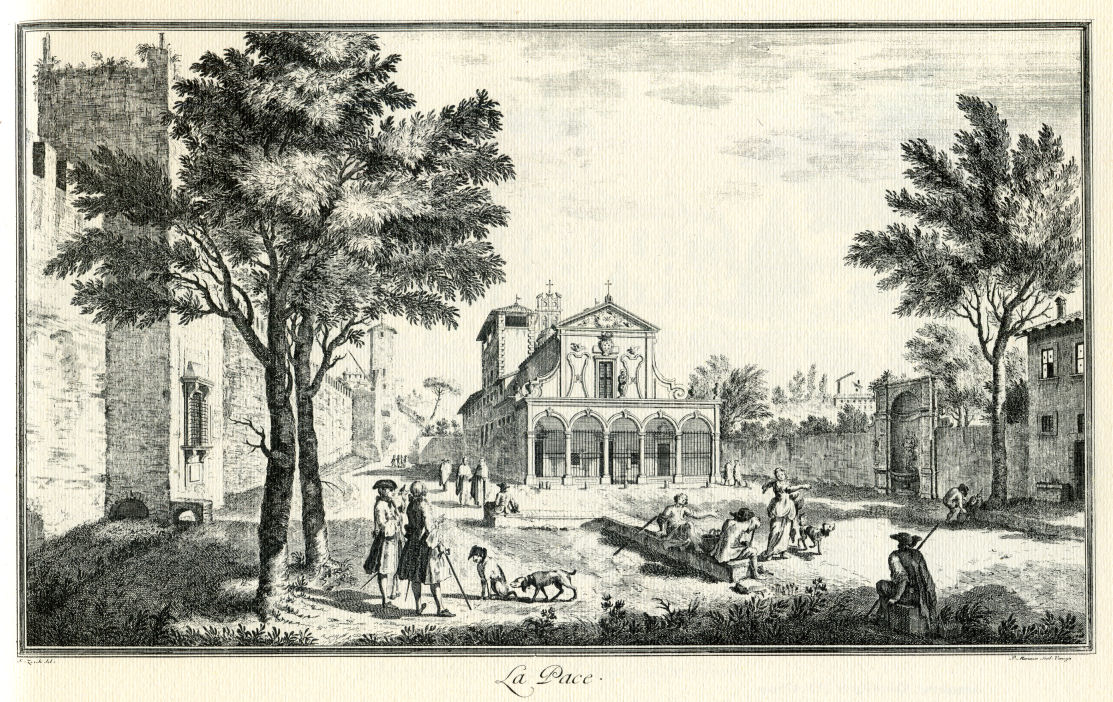
History
The church was built on the site of a chapel just outside the city walls
which had been demolished during the siege of Florence in 1529/30 so that
the besieging armies of the Holy Roman Emperor Charles V couldn't use them
for refuge or supplies. Consecrated in 1573 as Santa Maria della Neve and later dedicated to
Santa Maria della Pace. Part of a monastery which passed in 1616 to the
monks of Saint Bernard of Clairvaux. Later abandoned, and then converted to
private accommodation in the 19th century.
Demolished with the transfer of the Italian capital from Turin to
Florence, when it became necessary to create new royal stables. These
stables later became the current Art Institute.
The church in art
Painted by Fabio Borbottoni in
the late 19th century (see below).
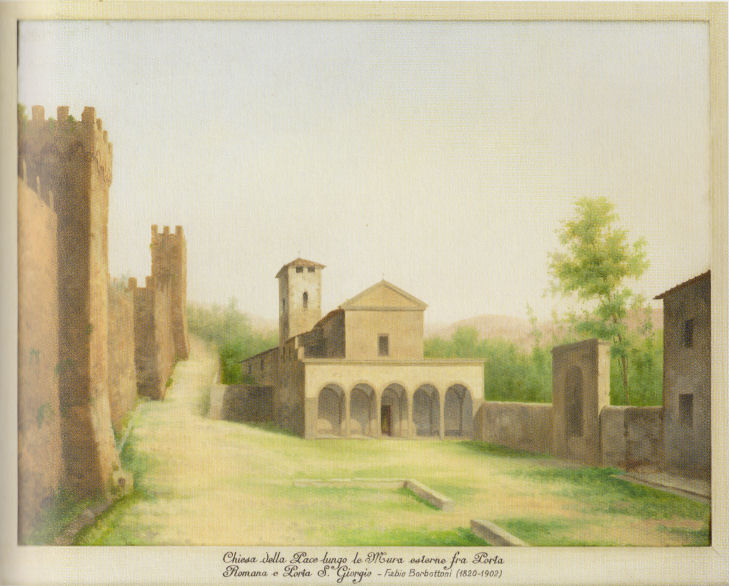
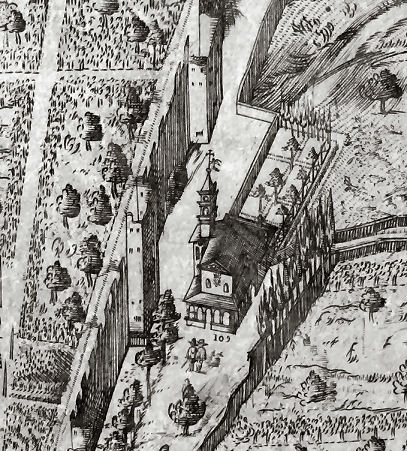
From the Buonsignori map of 1584
|
|
History
Church and monastery, on the via Pisana just outside
the San Frediano gate (approximately nos. 1-3-5-7 now) the
church was founded by the Bostichi family.
In the 14th century nuns of the Augustinian order of Santa Maria and San
Paolo settled in the monastery having abandoned
their monastery of San Paolo alla Casellina in Settimo. In 1483 the patronage of the church
passed from the Bostichi family to the Pucci. The
complex was one of those destroyed during the siege of 1529/30
so that the
attacking armies of the Holy Roman Emperor Charles V couldn't use them for refuge or supplies. Charles,
in league with the Medici Pope Clement VII, was intent on ending the
Florentine Republic for the last time and re-installing the Medici; and
succeeded.
The church in art
Painted by Fabio Borbottoni in
the late 19th century (see below).
This suggests that the church survived until then as an oratory.
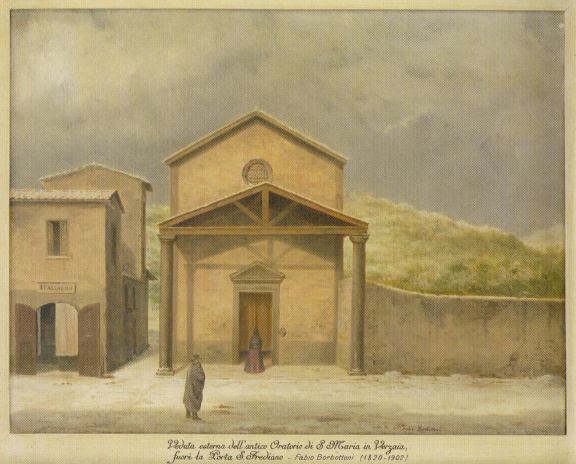
|
|
Santa Maria Sopr'Arno
|
|
Santa Maria sul Prato |
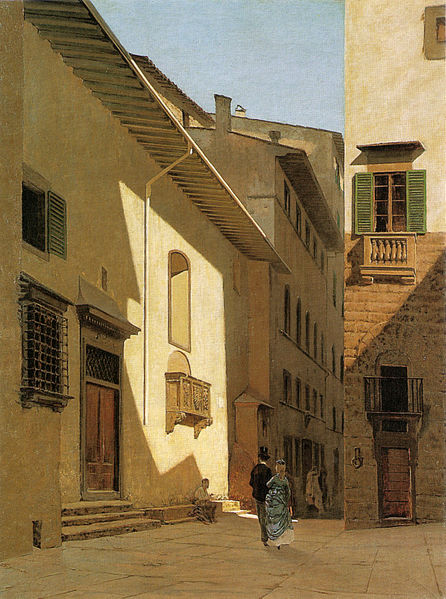
History
Also known as Santa Maria dei Bardi, this church is first
documented in 1181. It was rebuilt in 1210, paid for by Bardi family. A
plaque on the façade read "Fuccio
mi feci" and the date 1229, which had to have been the date of a
restructuring, not the building, which misled Vasari. The church was
closed on 13 May 1785 and the building, which was side-on to the river,
was demolished in 1869 during work on the widening of the embankments.
Lost art
The strange devil-bashing Virgin of Succour (1593) by Jacopo
Chimento (Empoli) was in the Barcagali-Perucci chapel here. It's now in
the Palatine Gallery in the Palazzo Pitti.
The church in art
There is a painting of the church by Telemaco Signorini (see left)
commissioned by the descendants of the Bardi family and painted shortly
before its demolition.
The church in literature
The 120th of the stories in the Trecentonovelle (300 stories)
by Franco Sacchetti (c.1335-1400).
|
|
Lost art
Mannerist Francesco Brina's Adoration of the Magi, with one magus
looking a bit like Michelangelo,
is in the Andrea del Sarto Cenacolo
Museum at San Salvi.
|



 Lost art
Lost art r at the Pitti in 1627.
r at the Pitti in 1627.








